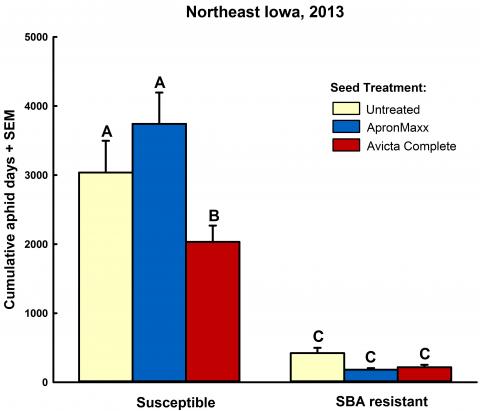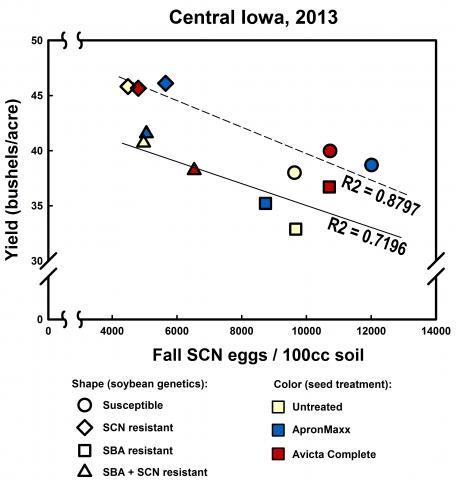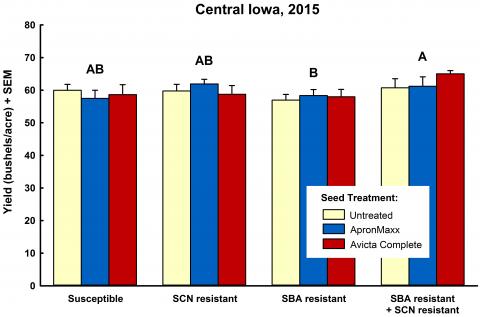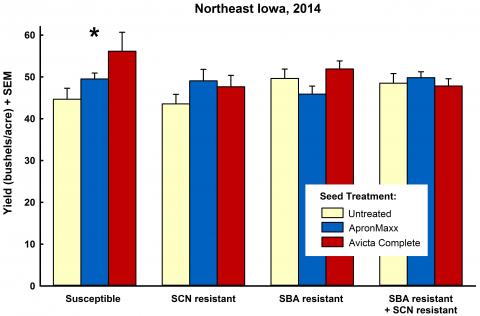By Erin Hodgson, Entomologist; Greg Tylka, Plant Pathologist
Soybean cyst nematode (SCN) and soybean aphid (SBA) are important soybean pests in the north-central region. Soybean varieties with host plant resistance for SCN (PI88788) and SBA (Rag1) can suppress pest populations and subsequently protect yield. In addition, seed treatments are becoming widely adopted and now can include a nematacide, fungicides and insecticide. Combining host plant resistance with seed treatments could potentially further protect yield. This article summarizes a 3-year research effort, funded by the soybean checkoff through a grant from the Iowa Soybean Association, that evaluated interactions among these two pests, host plant resistance and seed treatments.
Methods
Data were collected at two locations per year in Iowa during 2013, 2014 and 2015. Plots were arranged in a randomized complete block design with four soybean varieties, three seed treatments, and eight replications per treatment (96 plots at each location; 6 location-years):
- Soybean varieties: Susceptible to both SBA and SCN, SBA resistant, SCN resistant, and SBA+SCN resistant; and
- Seed treatments: Untreated, ApronMaxx (fungicides) and Avicta Complete (fungicides, insecticide and nematicide).
Data on the number of SBA per plant were collected weekly to estimate seasonal exposure, called cumulative aphid days (CAD). At planting and harvest, SCN eggs were sampled in each plot to assess SCN reproduction throughout the growing season.
Results from 3-Year Study
Soybean varieties with either SBA or SCN resistance had fewer pests compared to the susceptible variety. There was a significant reduction of CAD with SBA resistance (Fig. 1), and a significant reduction of SCN eggs with SCN resistance (Fig. 2).
 Figure 1. An example of reduced cumulative aphid days when aphids were exposed to aphid-resistant soybean compared to susceptible soybean; there were significant seed treatment soybean variety, and seed treatment x soybean variety effects.
Figure 1. An example of reduced cumulative aphid days when aphids were exposed to aphid-resistant soybean compared to susceptible soybean; there were significant seed treatment soybean variety, and seed treatment x soybean variety effects.
 Figure 2. An example of reduced soybean cyst nematode egg density on SCN-resistant soybean compared to susceptible soybean, with significant soybean variety effects. Dashed line represents a regression for SBA-susceptible soybean and solid line represents regression for SBA-resistant soybean. For every 1,000 SCN eggs, there was an approximate one bushel per acre yield loss.
Figure 2. An example of reduced soybean cyst nematode egg density on SCN-resistant soybean compared to susceptible soybean, with significant soybean variety effects. Dashed line represents a regression for SBA-susceptible soybean and solid line represents regression for SBA-resistant soybean. For every 1,000 SCN eggs, there was an approximate one bushel per acre yield loss.
Typical reproduction factor for SCN over the summers was twice as much in SCN-susceptible fields compared to SCN-resistant fields. These results support previous research findings that host plant resistance is an effective pest suppression tactic. Varieties with SCN resistance typically had higher yields than SCN susceptible varieties.
 Figure 3. An example of yield responses for soybean varieties and seed treatments, with significant soybean variety effects.
Figure 3. An example of yield responses for soybean varieties and seed treatments, with significant soybean variety effects.
Seed treatments did not consistently improve yields compared to untreated seed (Fig. 3). There was one instance of a significant yield increase with Avicta Complete Beans, in northwest Iowa in 2014, but only on the SBA and SCN susceptible variety (Fig. 4).
 Figure 4. Seed treatments significantly improved yield only at one location-year and only for the susceptible soybean variety (note asterisk).
Figure 4. Seed treatments significantly improved yield only at one location-year and only for the susceptible soybean variety (note asterisk).
Conclusions
SCN resistance is an effective suppression tool and there are many options for SCN resistance in Iowa in various maturity groups. SBA resistance is an effective suppression tool that can reduce the reliance of foliar insecticides. Unfortunately, there are no SBA-resistant varieties with herbicide tolerance available in Iowa. In general, seed treatments did not significantly increase yield compared to untreated seed. These results complement data from the Yellow Books for Soybean Aphid. Based on our results, it is difficult to know or predict when use of these seed treatments will further preserve yield.






Post a comment
Report Abusive Comment